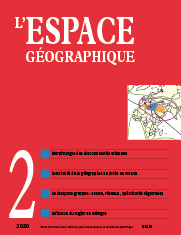

The urbanisation front: Concepts and spatial discontinuity detection methods (6 fig.)
Urbanisation fronts are often mentioned in French research on urban growth. However, although the term has entered the vocabulary of geographers, it does not have a commonly accepted definition, and has very few cartographical representations. This article provides, on the one hand, a reflection on the notion of urbanisation front based on Roger Brunet’s discontinuity theory. On the other hand, it presents a detection method of urbanisation fronts that uses spatiomorphological modelling, and a typology of the fronts as applied to the “Center Var” region in France.
keywords: DISCONTINUITY, MODELLING, MORPHOLOGY, URBAN GROWTH, URBANISATION FRONT
High school geography curricula in France from 1995 to 2019: A case of disciplinary instability (2 tabl.)
High school geography curricula between 1995 and 2019 in France are analysed as an institutional standard that prescribes both geographic contents to be selected and the work expected from teachers and students. The curricula also entail a specific link that must be made with scientific geography and the teaching body. They express the official objective that the geography discipline must contribute to for each new generation. Discourse analysis reveals that different standards follow one another during the 1995-2019 period, and that school geography as demanded by the institution is sometimes inconsistent.
keywords: DIDACTICS, INSTITUTIONAL STANDARD, SCHOOL CURRICULUM, SCHOOL GEOGRAPHY
Michel BRUNEAU. Hellenism and diaspora: Greek networks and the Greek state crisis (3 fig.)
Georges Prévélakis analyses the crisis that the Greek society and State are facing through a network lens, and introduces the notion of Hellenism. The diaspora, the Orthodox Church of the Ecumenical Patriarchate and the merchant navy, which are essential components of Hellenism, should enable the Greeks to break free from the debt burden by linking them to the rest of the world and to their long multimillennial history. Michel Bruneau had previously studied the genealogy of Hellenism and built a graphic model of this notion. Although both geographers acknowledge the reticular dimension of Hellenism, M. Bruneau does not believe that the Greeks, a long-lasting European people, can compensate for Greece’s demographic, economic and political weaknesses by resorting to this worldwide religious, diasporic and maritime dimension, even as they engage in the Chinese New Silk Roads project. They cannot escape the Western tropism of their diaspora and their membership in the European Union.
keywords: CRISIS, DIASPORA, EUROPE, HELLENISM, IDENTITY, NATION-STATE, NETWORKS, ORTHODOXY
The geopolitics of the Dodecanese diaspora: The regional specificity of a Greek network (2 encadrés; 2 fig.)
This article studies the evolution of a specific branch of the Greek diaspora, that of the Dodecanese islands. By relying on its geocultural specificities, this diaspora became an important driver of Greek foreign policy and played a crucial role in the incorporation of the Dodecanese archipelago to the Greek State (1947). In spite of state centralisation threatening to crush the network’s specificities, the Dodecanese diaspora today sets itself as a sub-national segment of the Greek diaspora, thanks to its resilience and its multiple connections.
keywords: ARCHIPELAGO, DIASPORA, GEOPOLITICS, GLOBALISATION, GREECE, NETWORKS
Emergence and diffusion of rugby union in Georgia (2 fig.)
Rugby union has been played in Georgia since 1959. However, it remained a confidential sport for a long time, before the country rose to the rank of “emerging nation” in the rugby world. In correlation with the performance of the male national team, nicknamed the Lelos, which has always qualified for in Rugby World Cup since 2003, the practice of rugby has gradually spread across the country. The study of this diffusion is based on the works of Hägerstrand, Rogers, Brown and Blaut. Beyond the conventional aspects of spatial diffusion, the study highlights the specific roles that media coverage, financialisation and cultural construction have played in making rugby union a national sport in Georgia.
keywords: GEORGIA, INNOVATION, RUGBY UNION, SPATIAL DIFFUSION, SPORT
Book reviews
In this issue of l’Espace géographique, you will find critical reviews of the following books
SOUCHAUD S. (2019). Géographie de l’atelier. Confection, migration, urbanisation à São Paulo. Paris: Éditions de l’Institut des Hautes Études de l’Amérique latine, 370 p. (Jean-Paul Deler, Cnrs Bordeaux) ISBN version papier: 978-2-37154-132-0 ISBN (eBook): 978-2-7099-2764-2
ADJEMIAN B. (2020). Les Petites Arménies de la vallée du Rhône. Histoire et mémoires des immigrations arméniennes en France. Lyon: Lieux Dits Éditions, 272 p. (Michel Bruneau, Cnrs Bordeaux) ISBN: 978-2-36219-198-5
L’espace géographique 1/20![]()
![]() L’espace géographique 3/20
L’espace géographique 3/20
For subscribe or buy this issue: BELIN
![]() L’Espace géographique: contents
L’Espace géographique: contents
Last modified: December 28, 2020